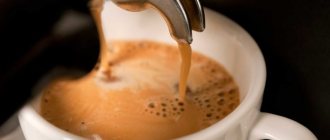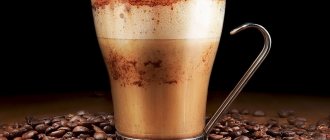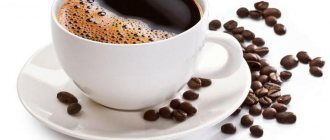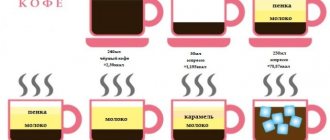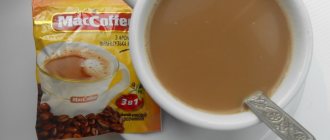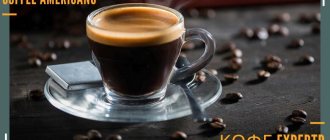Cappuccino is a favorite coffee drink for many people. It is drunk hot and cold (ice version), with the addition of milk foam or cream, with syrup or sugar, and spices are added. Most coffee drinkers simply enjoy the pleasant, creamy taste, but those watching their weight and calorie intake should be aware that this is a fairly nutritious coffee drink and learn to at least roughly estimate the calorie content of a cappuccino.
How many calories are in a standard serving of cappuccino?
First, let's define what is considered a standard. There are a lot of cooking options, and they vary depending on the specific establishment. Initially, the supply was 90 milliliters: 30 milliliters each of coffee, milk and whipped foam. Today, 150 or 180 milliliters are usually prepared, sometimes serving larger volumes is found, for example, in chain cafes, where coffee is served not in small heated cups, but in large cardboard glasses, 350-450 grams each, simply because it is profitable.
If you serve cappuccino according to all the rules, its portion will be exactly 150-180 milliliters.
The classic recipe does not involve the use of sweeteners. Light sweetness comes from whipped milk foam. And the overall nutritional component depends on the fat content and characteristics of this ingredient. In a standard recipe, 3-4% fat content is usually used, because the fat quickly and easily whips the liquid into a dense foam. A well-whipped foam should support the weight of a heaping teaspoon of granulated sugar, you can experiment in a coffee shop, but keep in mind that sweeteners seriously increase the overall nutritional value.
Milk with a fat content of 3.5% has 60 kilocalories per 100 grams. For preparation, take 100 or 120 ml. That is, in a cup it turns out:
- 2 kilocalories in ground grains;
- 60 – 72 kcal in dairy products.
Total - 62-74 in a standard cup without added sugar or sweeteners.
Compound
According to the classic Italian recipe, the drink is prepared from a third of espresso, milk and milk foam in the same quantity. Cocoa powder and grated chocolate with cinnamon are used for decoration.
100 g of cappuccino contains:
- protein – 1.8 g;
- fats – 4 g;
- carbohydrates – 14 g.
Sugar-free coffee contains 3.9 g of carbohydrates. The calorie content of cappuccino depends on the added components. They prepare coffee at home and in restaurants. There are several recipes for making the drink. Milk, cream, chocolate, cinnamon are added to it. Pour coffee into a heated cup. The spoon is left on the saucer: first the cream is eaten with it, and then the coffee is drunk.
Calorie content of cappuccino with different types of milk or cream
Different establishments prepare it differently, in some places the recipes are relatively standard, in others they offer a choice of different types of dairy products, for example, low-fat or soy. Sometimes they are cooked with cream; as a rule, they are either low-fat or low-calorie. Fatty ones are not used as they would have to be added in large quantities, which would change the taste to a decidedly creamy rather than coffee-like flavor and would affect the texture. We offer a calculation table with different types of additives per volume of 150 grams.
| Type of milk or cream | Kilocalories per 100 milliliters | Per 150 ml serving including two kcal in espresso |
| 0,1% | 31 | 33 |
| 1,5% | 44 | 46 |
| 2,5% | 52 | 54 |
| 3,5% | 61 | 63 |
| Soy 0.1% | 28 | 30 |
| Soy 0.6% | 43 | 45 |
| Skim cream | 60 | 62 |
| Cream 10% | 120 | 122 |
You can ask the barista to prepare you a drink with skim milk; many cafes, especially in large cities, have this option.
Chain cafe bars set their own standards for recipes, and usually indicate nutritional indicators in their recipes, as well as volume. You can get information either from the menu or from the websites of the companies you buy your drink from. For example, at McDonald's, all the menu details are usually written on a paper tray insert. Again, you can ask the waiter or the barista directly for the layout. For example, offer options from the most popular brands:
| Network name | Portion volume, ml | Nutritional significance |
| McDonald's | 200 / 300 | 75 / 123 |
| Starbucks | 350 | 140 |
| Coffee mania | 330 / 450 | 90 / 160 |
| Coffee House | 100 | 64 |
| Chocolate girl | 320 | 125 |
Calorie content of cappuccino from a machine
On average, coffee machines dispense 180-200 milliliters of liquid into a standard plastic cup.
It's difficult to make an accurate count because you usually have no idea what kind of dairy product is being used. Let's make a calculation for a standard 2.5% fat content, provided that natural grains are used and not soluble powder. 2 (coffee) + 62 (2.5% fat milk) = 64
Calories of the drink "Cappuccino" in bags
This, of course, is not entirely real coffee, but some people drink it too. As a rule, sugar is already added to the composition, as well as dry milk concentrate and flavorings, which increase the overall nutritional value. For example:
TORABIKA Cappuccino (25g) – 108;
Two sticks of LaFesta Cappuccino (25 g) – 114;
MacCoffee Cappuccino (25 g) – 104 kcal.
The energy value of a 3-in-1 cappuccino drink does not depend on how much water you pour. We made calculations for one bag. If you pour two sachets or sticks into a cup, double the calories.
Accurate information about fats, carbohydrates, etc. should be placed on the bag itself. There is an indicator per 100 grams. If you have a small bag, you can roughly divide the indicated number by 10, if the bag is large - by 4. Small deviations can be considered insignificant.
How many calories are in decaffeinated cappuccino?
All principles apply to the decaf option, if it is made on the basis of ground grains. Decaf is considered to contain 0-1 kilocalories, so you can either ignore this number altogether or add one to the nutritional value of the dairy product and sweetener. Or just be guided by our calculation table; the difference of a couple of points in this case is insignificant and can be ignored.
Benefits of coconut milk
The beneficial properties of coconut milk include:
- in cosmetology, this product is widely used to prepare masks for hair, face and body;
- lauric acid in coconut milk is characterized by pronounced antiviral, antifungal and antibacterial properties;
- the product stimulates the functions of the immune system, providing effective prevention of colds;
Read: Canned tuna salad: calorie content
- With regular consumption of coconut milk, the elasticity of the blood vessels of the circulatory system improves, thereby reducing the risk of developing diseases of the cardiovascular system;
- the antioxidant properties of such milk make it possible to use it for the prevention of cancer;
- the product helps normalize hemoglobin levels, blood sugar, and has a beneficial effect on blood pressure;
- it is a useful alternative to cow's milk if you are lactose intolerant;
- the product does not contain gluten, to which many people develop allergic reactions;
- Coconut milk stimulates the stomach and intestines, which speeds up metabolism and activates weight loss processes.
Calorie content of cappuccino with sugar
Each spoonful of sand added for sweetness significantly increases the overall energy and nutritional value. Moreover, the sweetish taste will already appear due to the whipped foam, and it is this that is considered the most valuable flavor shade, which should be enjoyed. However, for those who control their weight, but still do not give up their favorite sweet taste, here is a table for simple calculation.
| Type of sweetener | 5 g (level tsp) | 7 g (heaped tsp) | 10 g (1 or 2 sticks) |
| Sand | 19,5 | 27,3 | 39 |
| Reed | 20 | 28 | 40 |
Coffee syrups have an average nutritional value of 35-40 per 10 grams. Some manufacturers produce syrups with minimal energy value, but you can find them if you buy for yourself. In cafes they usually don’t think about this, and there are standard mass-produced options.
How to make a drawing on coffee (video)
If you've already mastered making cappuccino at home, the next step might be to learn the art of coffee painting. We recommend watching a video where a professional barista shows how to quickly and easily draw a bear on a freshly prepared cappuccino.
If you love cappuccino for its low calorie content, and prefer it to other coffee drinks, you probably know the secrets of making it or reducing calorie content, and you can also recommend which healthy snacks are best suited to this delicious drink. We are looking forward to comments from coffee lovers or those who are losing weight with coffee, because thanks to your feedback, many will discover this divine drink.
Author of the publication
Conclusions:
- The calorie content of a regular serving of cappuccino, 150-180 milliliters, without sweeteners and with full-fat milk is 62-74 kilocalories.
- Adding one medium spoon of granulated sugar increases the nutritional value by about 20 kcal.
- Mostly calories are added from dairy products or syrups; the espresso base itself has a nutritional value of about 1-2, and this number can be ignored.
- A cappuccino drink from a coffee machine, 180 ml, contains about 100-110 kilocalories, without added sugar.
- The larger the volume, the more milk component, and therefore more calories.
What nutritionists say
Pure coffee is an excellent low-calorie product for weight loss. Numerous studies show that caffeine reduces appetite and promotes rapid energy expenditure. This allows you to drink coffee while dieting for weight loss.
There are even Cappuccino drinks for weight loss without sugar based on coffee or chicory. They are instant and contain additional fat burning ingredients. If you can’t resist a cup of cappuccino, but don’t want extra calories, we recommend sticking to these rules.
- do not add sugar, syrup or other sweeteners;
- choose a drink with milk of minimal fat content;
- choose a small portion;
- add spices (cinnamon, nutmeg).
These simple rules will have a minimal impact on the pleasure you get from the drink, but will reduce its calorie content several times.
If you are following a diet for weight loss and cannot decide what to treat yourself to sometimes - cappuccino or, for example, chocolate, then it is worth remembering that the calorie content of chocolate is several times higher than this delicious coffee drink. And the pleasure of cappuccino can be extended for longer.
How to use in dietetics and weight loss
In addition to cappuccino, the daily diet consists of:
Using the same principle, you can calculate the calorie content of coffee brewed in a Turk, French press, pour over, or geyser coffee maker. The value of the indicator depends not on the volume of water, but on the number of ground grains.
Cappuccino is served in a preheated tall (120-150) ml glass and garnished with ground chocolate or cinnamon. There is a special Latte Art trend in which a drawing is placed on the surface of the milk foam. Some barristos are so successful in this art that they can depict not only an ornament, but also any animal or portrait of a person.
Expert opinion
Valeria Cherkasova, bonus programs specialist
Syrups It is endowed with a wide range of tastes from sweetish-soft to sharp and tart. These data are for natural espresso and dairy ingredients. But coffee makers do not always use these specific ingredients. Quite often you can find soluble powders and concentrates. For more information on this issue, please contact me!
The most high-calorie items on the Starbucks menu
If you put that much into regular coffee, no one would be able to drink it. Even milk contains 1.5% fat, and its calorie content is 44 kcal/100 g. If you add just one tablespoon to a cup, the nutritional value of the drink will increase by 9 kcal. The higher the fat content of the milk, the higher the calorie content of coffee with milk:
The exact numbers depend on the specific manufacturer, so it is best to look at the composition data on the packaging. But for most, the difference is not that big, and a deviation of +/- 2-3 kilocalories is not significant for anyone.
Energy value of other types of drink
If instant coffee was used in the preparation of cappuccino, then the calorie content of such a drink will be similar to coffee beans. The average value of instant cappuccino is 90 kilocalories. To prepare a double cappuccino, you should take double the ingredients. Therefore, the calorie content of such a drink will be twice as high. If cream is added to cappuccino, then in addition to the softened taste, there is a significant increase in calorie content. Just one spoon of this product gives an increase in kilocalories by 60 units. Those who like a sweeter drink can also add condensed milk. This additive also makes the taste of cappuccino softer, but also brings its own kilocalories. A teaspoon of condensed milk adds 36 units.
General theory
How to make cappuccino coffee, you ask? The canonical cappuccino consists of three equal parts:
- espresso;
- milk;
- milk foam.
Invented in Italy, the term comes from the name of the Capuchin monastic order. What connection can be traced between him and the clergy? It's very simple: in the 17th century, the word cappuccino was used to refer to the color red-brown. This is the color of the robe that the monks wore. True, in relation to the drink, the name took root only in the 20th century.
Indeed, if you look closely, the foam on the cappuccino resembles a hood
There is also a version that this type of coffee was named so due to the fact that when whipped cream is added to espresso, a pyramid-shaped foam is formed on the surface, vaguely reminiscent of a capuchin’s hood.
According to legend, one day a representative of the Franciscan Order, while drinking coffee with goat's milk, noticed that foam suddenly appeared on top of the drink. I liked the delicate taste, and the brothers in faith decided to henceforth achieve the same airiness and a similar state from the coffee delicacy. At first, milk was churned by hand. The first cappuccino machine was made by an amateur technician named Giuseppe, who lived near the monastery of Capuchin monks.
As for the energy value, 100 milliliters of the drink contains over 400 kilocalories. When replenishing the container with sweet additives, the calorie content of cappuccino coffee naturally increases.
What affects the taste of a coffee product? Firstly, the type of coffee, secondly, the grinding and, finally, the correct preparation. The first step is to properly brew an espresso drink from high-quality coffee beans.
For this purpose, it is preferable to take ground assorted Arabica and Robusta beans. The volume of water for brewing one serving should not exceed 50 milliliters, and the weight of the coffee ingredient should not exceed 7 grams. Of course, you can resort to instant cappuccino coffee, but then we will not get that exquisite aroma that is inherent in natural ground coffee.
The freshest milk is purchased for adding to cappuccino. Otherwise, when heated, it curls and ruins the drink. In addition, it should be a fatty product - it is ideal for creating foam. The low-fat variation has a weak bluish consistency with large bubbles.
To add unique flavor notes to cappuccino, coffee, to add calories, sprinkle the foam with the following delicacies:
- chocolate or nut crumbs;
- cinnamon;
- powdered sugar;
- cocoa;
- various spices.
Differences between cappuccino...
...from espresso
They have something in common, in particular, the product we are reviewing is prepared on the basis of a “competitor”. Just like cappuccino, espresso is made in a special machine, because to obtain the drink requires the passage of water under high pressure through a coffee tablet. The difference between cappuccino and espresso is that espresso does not have separate layers, and the drink can be served in the form of a double portion - doppio.
This delicate cappuccino is based on aromatic espresso.
... from latte
Many people who do not often drink cappuccino may confuse it with a latte. And not surprisingly, they are really similar. We will discuss how to make cappuccino coffee a little lower, but in general terms we will note the following: cappuccino is when milk is placed on top of espresso, and not vice versa. Differences are also found in the proportionality of the constituent elements - there is three times more milk in a latte than coffee. Nowadays it is believed that cappuccino is still a coffee drink, and latte is a cocktail made of milk and coffee. And if the first one is drunk from a cup, then the second one is drunk from a transparent glass. Lattes are usually topped with berry-fruit syrup. As for the foam slide, it is thick in a cappuccino, while in a latte it is more airy and light. Here, in general terms, is the difference between a latte and a cappuccino.
... from mochaccino
In terms of the constituent base, both drinks are the same, however, in addition to the standard base, mochaccino includes chocolate syrup (“liquefied chocolate”). Compared to cappuccino, the coffee share is reduced here, and coffee takes place after milk and syrup.
... from Americano
We have already studied the composition of cappuccino coffee thoroughly, and as for Americano, it lacks milk and foam as such - it is produced using espresso, fairly diluted with water.
...from macchiato
Cappuccino contains three layers of products in equal proportions, while macchiato emphasizes the dominant role of coffee. When brewing a macchiato, it is the coffee liquid that is introduced into the milk so that the signature coffee-leopard spots appear on its foamy surface. Translated from foreign languages, macchiato means “spotted”.
